Detailed Analysis of Auditing, Assurance and Compliance Report
VerifiedAdded on 2020/03/02
|10
|2485
|30
Report
AI Summary
This report presents an analysis of an auditing, assurance, and compliance case study, focusing on the financial performance of DIPL over three fiscal years. It examines the application of analytical procedures, including ratio analysis and benchmarking, to assess DIPL's financial position, highlighting declining profit margins and solvency ratios. The report identifies inherent risks, such as inexperienced staff and potential fraudulent financial reporting, and their impact on the company's operations. It explores specific risks, including those related to fraudulent activities and the use of an average costing method. The report concludes with recommendations for mitigating identified risks and improving financial reporting practices, emphasizing the need for enhanced monitoring systems and accurate cost accounting to ensure financial integrity and compliance.
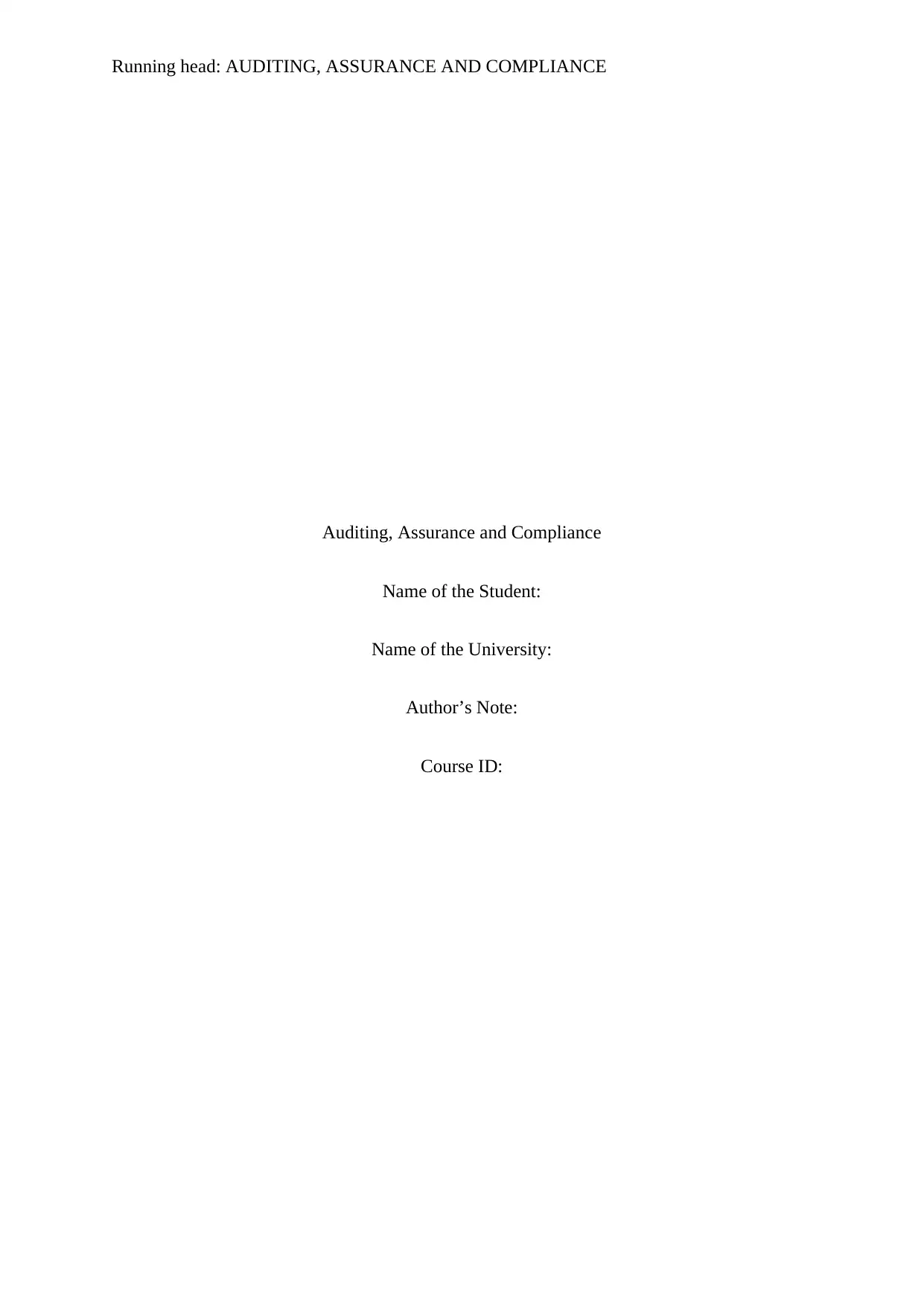
Running head: AUDITING, ASSURANCE AND COMPLIANCE
Auditing, Assurance and Compliance
Name of the Student:
Name of the University:
Author’s Note:
Course ID:
Auditing, Assurance and Compliance
Name of the Student:
Name of the University:
Author’s Note:
Course ID:
Paraphrase This Document
Need a fresh take? Get an instant paraphrase of this document with our AI Paraphraser
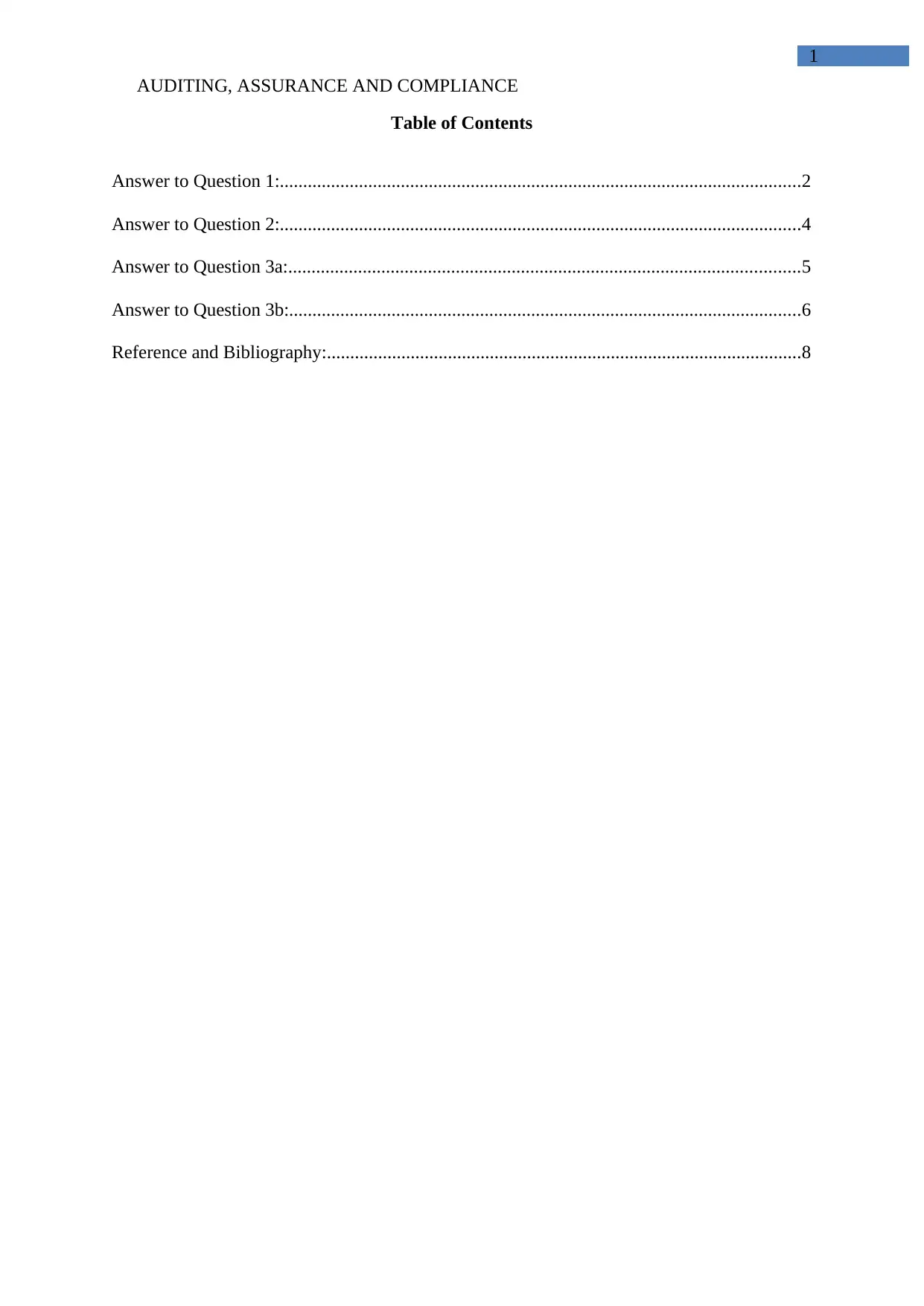
AUDITING, ASSURANCE AND COMPLIANCE
1
Table of Contents
Answer to Question 1:................................................................................................................2
Answer to Question 2:................................................................................................................4
Answer to Question 3a:..............................................................................................................5
Answer to Question 3b:..............................................................................................................6
Reference and Bibliography:......................................................................................................8
1
Table of Contents
Answer to Question 1:................................................................................................................2
Answer to Question 2:................................................................................................................4
Answer to Question 3a:..............................................................................................................5
Answer to Question 3b:..............................................................................................................6
Reference and Bibliography:......................................................................................................8
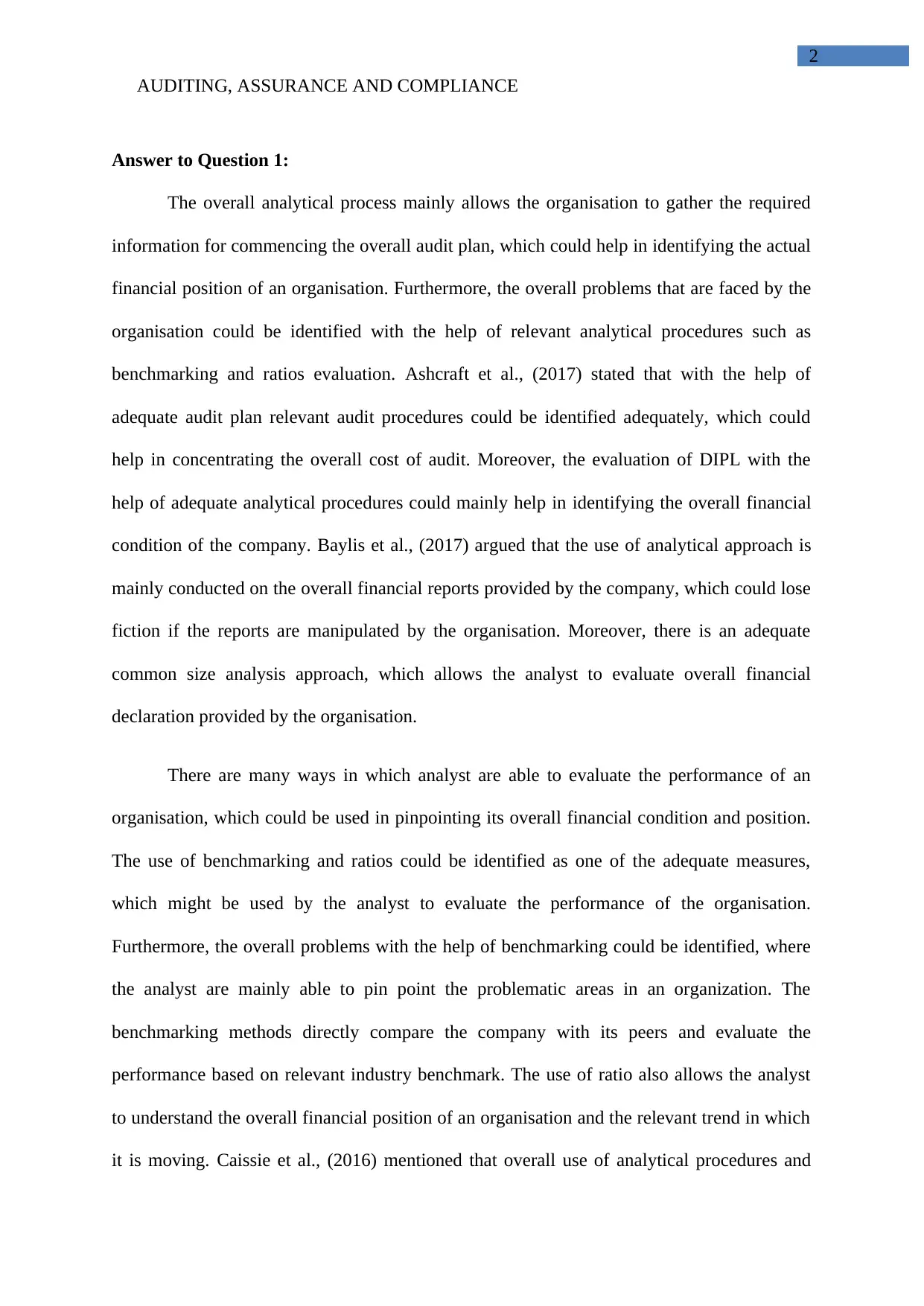
AUDITING, ASSURANCE AND COMPLIANCE
2
Answer to Question 1:
The overall analytical process mainly allows the organisation to gather the required
information for commencing the overall audit plan, which could help in identifying the actual
financial position of an organisation. Furthermore, the overall problems that are faced by the
organisation could be identified with the help of relevant analytical procedures such as
benchmarking and ratios evaluation. Ashcraft et al., (2017) stated that with the help of
adequate audit plan relevant audit procedures could be identified adequately, which could
help in concentrating the overall cost of audit. Moreover, the evaluation of DIPL with the
help of adequate analytical procedures could mainly help in identifying the overall financial
condition of the company. Baylis et al., (2017) argued that the use of analytical approach is
mainly conducted on the overall financial reports provided by the company, which could lose
fiction if the reports are manipulated by the organisation. Moreover, there is an adequate
common size analysis approach, which allows the analyst to evaluate overall financial
declaration provided by the organisation.
There are many ways in which analyst are able to evaluate the performance of an
organisation, which could be used in pinpointing its overall financial condition and position.
The use of benchmarking and ratios could be identified as one of the adequate measures,
which might be used by the analyst to evaluate the performance of the organisation.
Furthermore, the overall problems with the help of benchmarking could be identified, where
the analyst are mainly able to pin point the problematic areas in an organization. The
benchmarking methods directly compare the company with its peers and evaluate the
performance based on relevant industry benchmark. The use of ratio also allows the analyst
to understand the overall financial position of an organisation and the relevant trend in which
it is moving. Caissie et al., (2016) mentioned that overall use of analytical procedures and
2
Answer to Question 1:
The overall analytical process mainly allows the organisation to gather the required
information for commencing the overall audit plan, which could help in identifying the actual
financial position of an organisation. Furthermore, the overall problems that are faced by the
organisation could be identified with the help of relevant analytical procedures such as
benchmarking and ratios evaluation. Ashcraft et al., (2017) stated that with the help of
adequate audit plan relevant audit procedures could be identified adequately, which could
help in concentrating the overall cost of audit. Moreover, the evaluation of DIPL with the
help of adequate analytical procedures could mainly help in identifying the overall financial
condition of the company. Baylis et al., (2017) argued that the use of analytical approach is
mainly conducted on the overall financial reports provided by the company, which could lose
fiction if the reports are manipulated by the organisation. Moreover, there is an adequate
common size analysis approach, which allows the analyst to evaluate overall financial
declaration provided by the organisation.
There are many ways in which analyst are able to evaluate the performance of an
organisation, which could be used in pinpointing its overall financial condition and position.
The use of benchmarking and ratios could be identified as one of the adequate measures,
which might be used by the analyst to evaluate the performance of the organisation.
Furthermore, the overall problems with the help of benchmarking could be identified, where
the analyst are mainly able to pin point the problematic areas in an organization. The
benchmarking methods directly compare the company with its peers and evaluate the
performance based on relevant industry benchmark. The use of ratio also allows the analyst
to understand the overall financial position of an organisation and the relevant trend in which
it is moving. Caissie et al., (2016) mentioned that overall use of analytical procedures and
⊘ This is a preview!⊘
Do you want full access?
Subscribe today to unlock all pages.

Trusted by 1+ million students worldwide
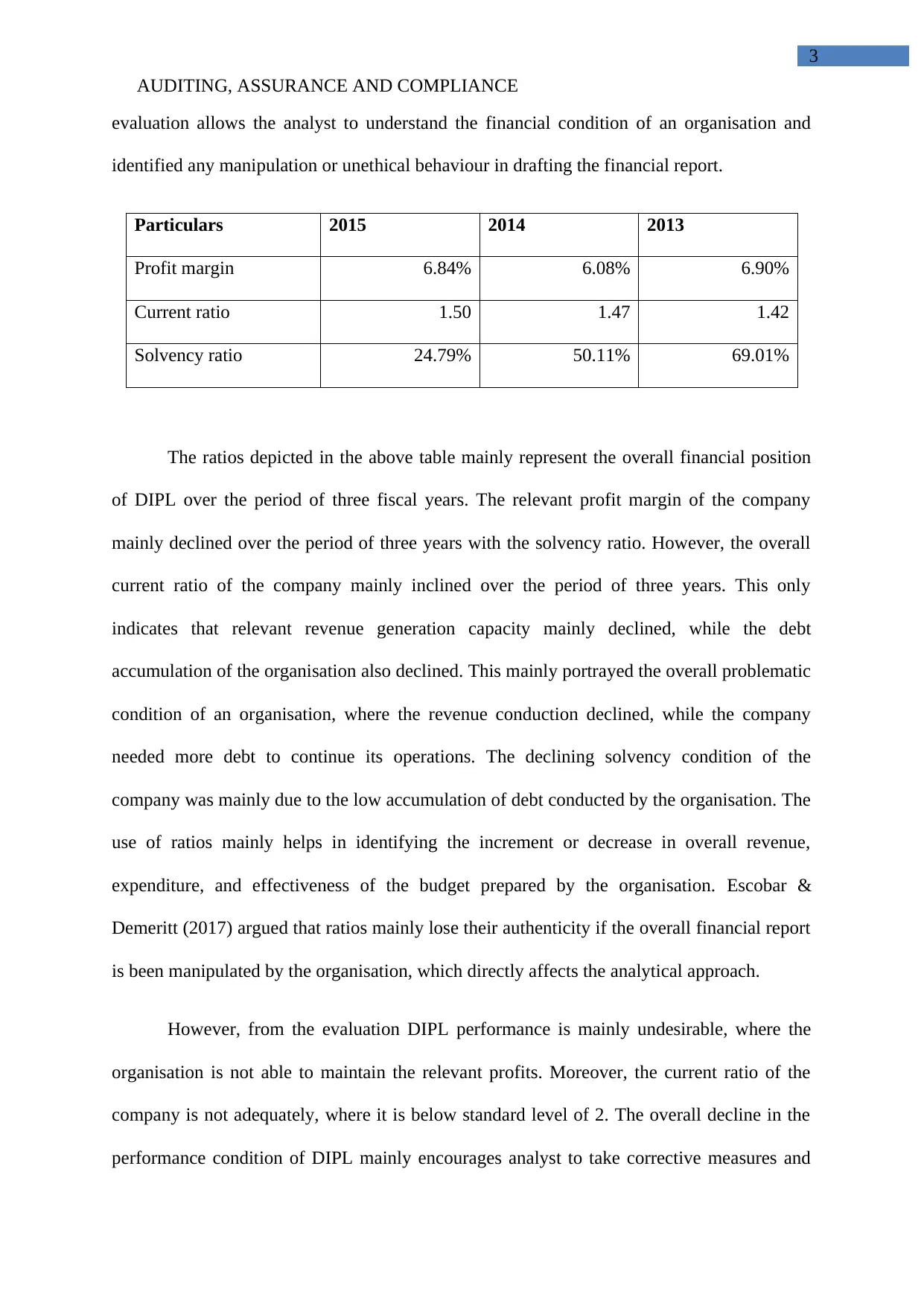
AUDITING, ASSURANCE AND COMPLIANCE
3
evaluation allows the analyst to understand the financial condition of an organisation and
identified any manipulation or unethical behaviour in drafting the financial report.
Particulars 2015 2014 2013
Profit margin 6.84% 6.08% 6.90%
Current ratio 1.50 1.47 1.42
Solvency ratio 24.79% 50.11% 69.01%
The ratios depicted in the above table mainly represent the overall financial position
of DIPL over the period of three fiscal years. The relevant profit margin of the company
mainly declined over the period of three years with the solvency ratio. However, the overall
current ratio of the company mainly inclined over the period of three years. This only
indicates that relevant revenue generation capacity mainly declined, while the debt
accumulation of the organisation also declined. This mainly portrayed the overall problematic
condition of an organisation, where the revenue conduction declined, while the company
needed more debt to continue its operations. The declining solvency condition of the
company was mainly due to the low accumulation of debt conducted by the organisation. The
use of ratios mainly helps in identifying the increment or decrease in overall revenue,
expenditure, and effectiveness of the budget prepared by the organisation. Escobar &
Demeritt (2017) argued that ratios mainly lose their authenticity if the overall financial report
is been manipulated by the organisation, which directly affects the analytical approach.
However, from the evaluation DIPL performance is mainly undesirable, where the
organisation is not able to maintain the relevant profits. Moreover, the current ratio of the
company is not adequately, where it is below standard level of 2. The overall decline in the
performance condition of DIPL mainly encourages analyst to take corrective measures and
3
evaluation allows the analyst to understand the financial condition of an organisation and
identified any manipulation or unethical behaviour in drafting the financial report.
Particulars 2015 2014 2013
Profit margin 6.84% 6.08% 6.90%
Current ratio 1.50 1.47 1.42
Solvency ratio 24.79% 50.11% 69.01%
The ratios depicted in the above table mainly represent the overall financial position
of DIPL over the period of three fiscal years. The relevant profit margin of the company
mainly declined over the period of three years with the solvency ratio. However, the overall
current ratio of the company mainly inclined over the period of three years. This only
indicates that relevant revenue generation capacity mainly declined, while the debt
accumulation of the organisation also declined. This mainly portrayed the overall problematic
condition of an organisation, where the revenue conduction declined, while the company
needed more debt to continue its operations. The declining solvency condition of the
company was mainly due to the low accumulation of debt conducted by the organisation. The
use of ratios mainly helps in identifying the increment or decrease in overall revenue,
expenditure, and effectiveness of the budget prepared by the organisation. Escobar &
Demeritt (2017) argued that ratios mainly lose their authenticity if the overall financial report
is been manipulated by the organisation, which directly affects the analytical approach.
However, from the evaluation DIPL performance is mainly undesirable, where the
organisation is not able to maintain the relevant profits. Moreover, the current ratio of the
company is not adequately, where it is below standard level of 2. The overall decline in the
performance condition of DIPL mainly encourages analyst to take corrective measures and
Paraphrase This Document
Need a fresh take? Get an instant paraphrase of this document with our AI Paraphraser
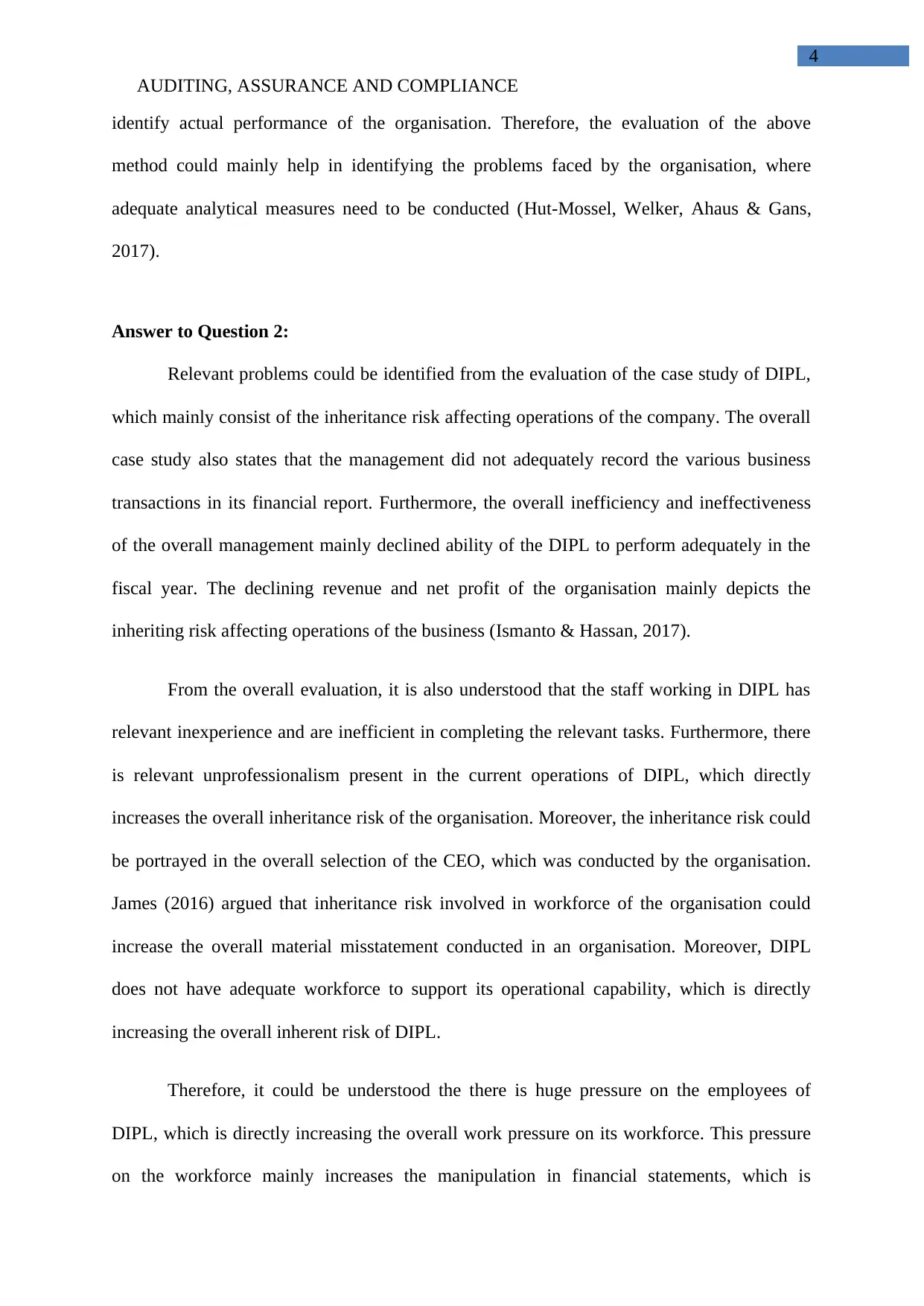
AUDITING, ASSURANCE AND COMPLIANCE
4
identify actual performance of the organisation. Therefore, the evaluation of the above
method could mainly help in identifying the problems faced by the organisation, where
adequate analytical measures need to be conducted (Hut-Mossel, Welker, Ahaus & Gans,
2017).
Answer to Question 2:
Relevant problems could be identified from the evaluation of the case study of DIPL,
which mainly consist of the inheritance risk affecting operations of the company. The overall
case study also states that the management did not adequately record the various business
transactions in its financial report. Furthermore, the overall inefficiency and ineffectiveness
of the overall management mainly declined ability of the DIPL to perform adequately in the
fiscal year. The declining revenue and net profit of the organisation mainly depicts the
inheriting risk affecting operations of the business (Ismanto & Hassan, 2017).
From the overall evaluation, it is also understood that the staff working in DIPL has
relevant inexperience and are inefficient in completing the relevant tasks. Furthermore, there
is relevant unprofessionalism present in the current operations of DIPL, which directly
increases the overall inheritance risk of the organisation. Moreover, the inheritance risk could
be portrayed in the overall selection of the CEO, which was conducted by the organisation.
James (2016) argued that inheritance risk involved in workforce of the organisation could
increase the overall material misstatement conducted in an organisation. Moreover, DIPL
does not have adequate workforce to support its operational capability, which is directly
increasing the overall inherent risk of DIPL.
Therefore, it could be understood the there is huge pressure on the employees of
DIPL, which is directly increasing the overall work pressure on its workforce. This pressure
on the workforce mainly increases the manipulation in financial statements, which is
4
identify actual performance of the organisation. Therefore, the evaluation of the above
method could mainly help in identifying the problems faced by the organisation, where
adequate analytical measures need to be conducted (Hut-Mossel, Welker, Ahaus & Gans,
2017).
Answer to Question 2:
Relevant problems could be identified from the evaluation of the case study of DIPL,
which mainly consist of the inheritance risk affecting operations of the company. The overall
case study also states that the management did not adequately record the various business
transactions in its financial report. Furthermore, the overall inefficiency and ineffectiveness
of the overall management mainly declined ability of the DIPL to perform adequately in the
fiscal year. The declining revenue and net profit of the organisation mainly depicts the
inheriting risk affecting operations of the business (Ismanto & Hassan, 2017).
From the overall evaluation, it is also understood that the staff working in DIPL has
relevant inexperience and are inefficient in completing the relevant tasks. Furthermore, there
is relevant unprofessionalism present in the current operations of DIPL, which directly
increases the overall inheritance risk of the organisation. Moreover, the inheritance risk could
be portrayed in the overall selection of the CEO, which was conducted by the organisation.
James (2016) argued that inheritance risk involved in workforce of the organisation could
increase the overall material misstatement conducted in an organisation. Moreover, DIPL
does not have adequate workforce to support its operational capability, which is directly
increasing the overall inherent risk of DIPL.
Therefore, it could be understood the there is huge pressure on the employees of
DIPL, which is directly increasing the overall work pressure on its workforce. This pressure
on the workforce mainly increases the manipulation in financial statements, which is
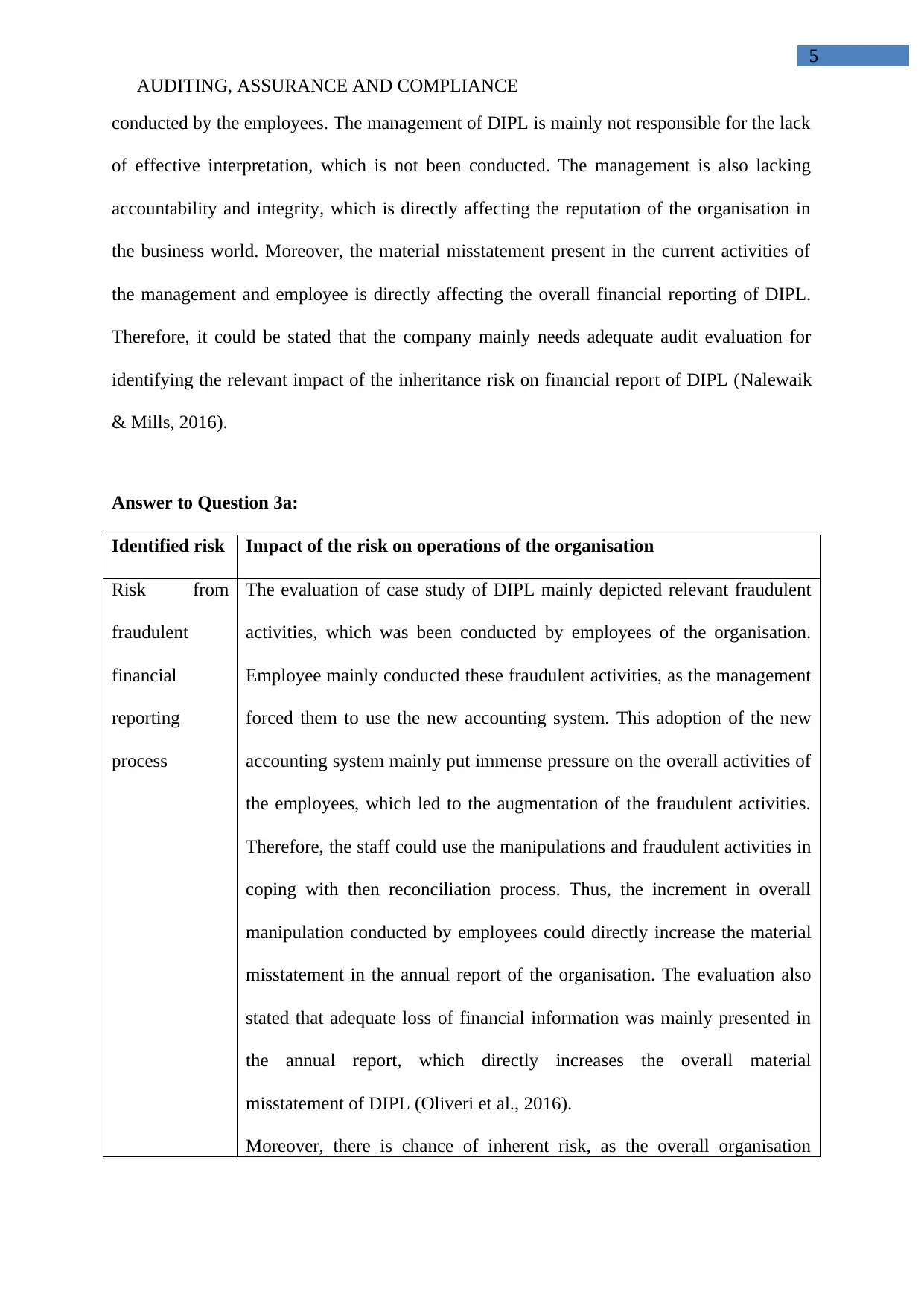
AUDITING, ASSURANCE AND COMPLIANCE
5
conducted by the employees. The management of DIPL is mainly not responsible for the lack
of effective interpretation, which is not been conducted. The management is also lacking
accountability and integrity, which is directly affecting the reputation of the organisation in
the business world. Moreover, the material misstatement present in the current activities of
the management and employee is directly affecting the overall financial reporting of DIPL.
Therefore, it could be stated that the company mainly needs adequate audit evaluation for
identifying the relevant impact of the inheritance risk on financial report of DIPL (Nalewaik
& Mills, 2016).
Answer to Question 3a:
Identified risk Impact of the risk on operations of the organisation
Risk from
fraudulent
financial
reporting
process
The evaluation of case study of DIPL mainly depicted relevant fraudulent
activities, which was been conducted by employees of the organisation.
Employee mainly conducted these fraudulent activities, as the management
forced them to use the new accounting system. This adoption of the new
accounting system mainly put immense pressure on the overall activities of
the employees, which led to the augmentation of the fraudulent activities.
Therefore, the staff could use the manipulations and fraudulent activities in
coping with then reconciliation process. Thus, the increment in overall
manipulation conducted by employees could directly increase the material
misstatement in the annual report of the organisation. The evaluation also
stated that adequate loss of financial information was mainly presented in
the annual report, which directly increases the overall material
misstatement of DIPL (Oliveri et al., 2016).
Moreover, there is chance of inherent risk, as the overall organisation
5
conducted by the employees. The management of DIPL is mainly not responsible for the lack
of effective interpretation, which is not been conducted. The management is also lacking
accountability and integrity, which is directly affecting the reputation of the organisation in
the business world. Moreover, the material misstatement present in the current activities of
the management and employee is directly affecting the overall financial reporting of DIPL.
Therefore, it could be stated that the company mainly needs adequate audit evaluation for
identifying the relevant impact of the inheritance risk on financial report of DIPL (Nalewaik
& Mills, 2016).
Answer to Question 3a:
Identified risk Impact of the risk on operations of the organisation
Risk from
fraudulent
financial
reporting
process
The evaluation of case study of DIPL mainly depicted relevant fraudulent
activities, which was been conducted by employees of the organisation.
Employee mainly conducted these fraudulent activities, as the management
forced them to use the new accounting system. This adoption of the new
accounting system mainly put immense pressure on the overall activities of
the employees, which led to the augmentation of the fraudulent activities.
Therefore, the staff could use the manipulations and fraudulent activities in
coping with then reconciliation process. Thus, the increment in overall
manipulation conducted by employees could directly increase the material
misstatement in the annual report of the organisation. The evaluation also
stated that adequate loss of financial information was mainly presented in
the annual report, which directly increases the overall material
misstatement of DIPL (Oliveri et al., 2016).
Moreover, there is chance of inherent risk, as the overall organisation
⊘ This is a preview!⊘
Do you want full access?
Subscribe today to unlock all pages.

Trusted by 1+ million students worldwide
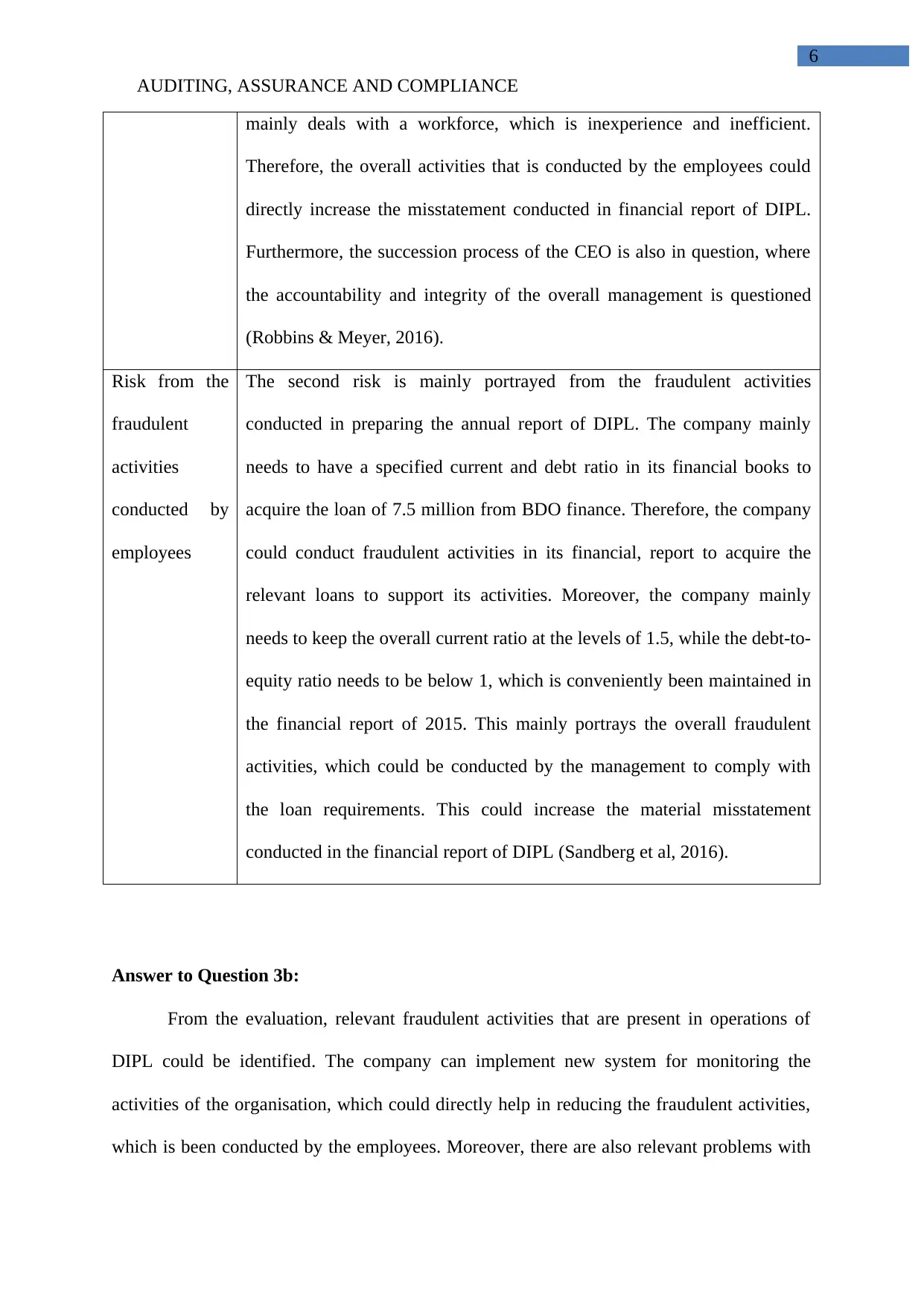
AUDITING, ASSURANCE AND COMPLIANCE
6
mainly deals with a workforce, which is inexperience and inefficient.
Therefore, the overall activities that is conducted by the employees could
directly increase the misstatement conducted in financial report of DIPL.
Furthermore, the succession process of the CEO is also in question, where
the accountability and integrity of the overall management is questioned
(Robbins & Meyer, 2016).
Risk from the
fraudulent
activities
conducted by
employees
The second risk is mainly portrayed from the fraudulent activities
conducted in preparing the annual report of DIPL. The company mainly
needs to have a specified current and debt ratio in its financial books to
acquire the loan of 7.5 million from BDO finance. Therefore, the company
could conduct fraudulent activities in its financial, report to acquire the
relevant loans to support its activities. Moreover, the company mainly
needs to keep the overall current ratio at the levels of 1.5, while the debt-to-
equity ratio needs to be below 1, which is conveniently been maintained in
the financial report of 2015. This mainly portrays the overall fraudulent
activities, which could be conducted by the management to comply with
the loan requirements. This could increase the material misstatement
conducted in the financial report of DIPL (Sandberg et al, 2016).
Answer to Question 3b:
From the evaluation, relevant fraudulent activities that are present in operations of
DIPL could be identified. The company can implement new system for monitoring the
activities of the organisation, which could directly help in reducing the fraudulent activities,
which is been conducted by the employees. Moreover, there are also relevant problems with
6
mainly deals with a workforce, which is inexperience and inefficient.
Therefore, the overall activities that is conducted by the employees could
directly increase the misstatement conducted in financial report of DIPL.
Furthermore, the succession process of the CEO is also in question, where
the accountability and integrity of the overall management is questioned
(Robbins & Meyer, 2016).
Risk from the
fraudulent
activities
conducted by
employees
The second risk is mainly portrayed from the fraudulent activities
conducted in preparing the annual report of DIPL. The company mainly
needs to have a specified current and debt ratio in its financial books to
acquire the loan of 7.5 million from BDO finance. Therefore, the company
could conduct fraudulent activities in its financial, report to acquire the
relevant loans to support its activities. Moreover, the company mainly
needs to keep the overall current ratio at the levels of 1.5, while the debt-to-
equity ratio needs to be below 1, which is conveniently been maintained in
the financial report of 2015. This mainly portrays the overall fraudulent
activities, which could be conducted by the management to comply with
the loan requirements. This could increase the material misstatement
conducted in the financial report of DIPL (Sandberg et al, 2016).
Answer to Question 3b:
From the evaluation, relevant fraudulent activities that are present in operations of
DIPL could be identified. The company can implement new system for monitoring the
activities of the organisation, which could directly help in reducing the fraudulent activities,
which is been conducted by the employees. Moreover, there are also relevant problems with
Paraphrase This Document
Need a fresh take? Get an instant paraphrase of this document with our AI Paraphraser
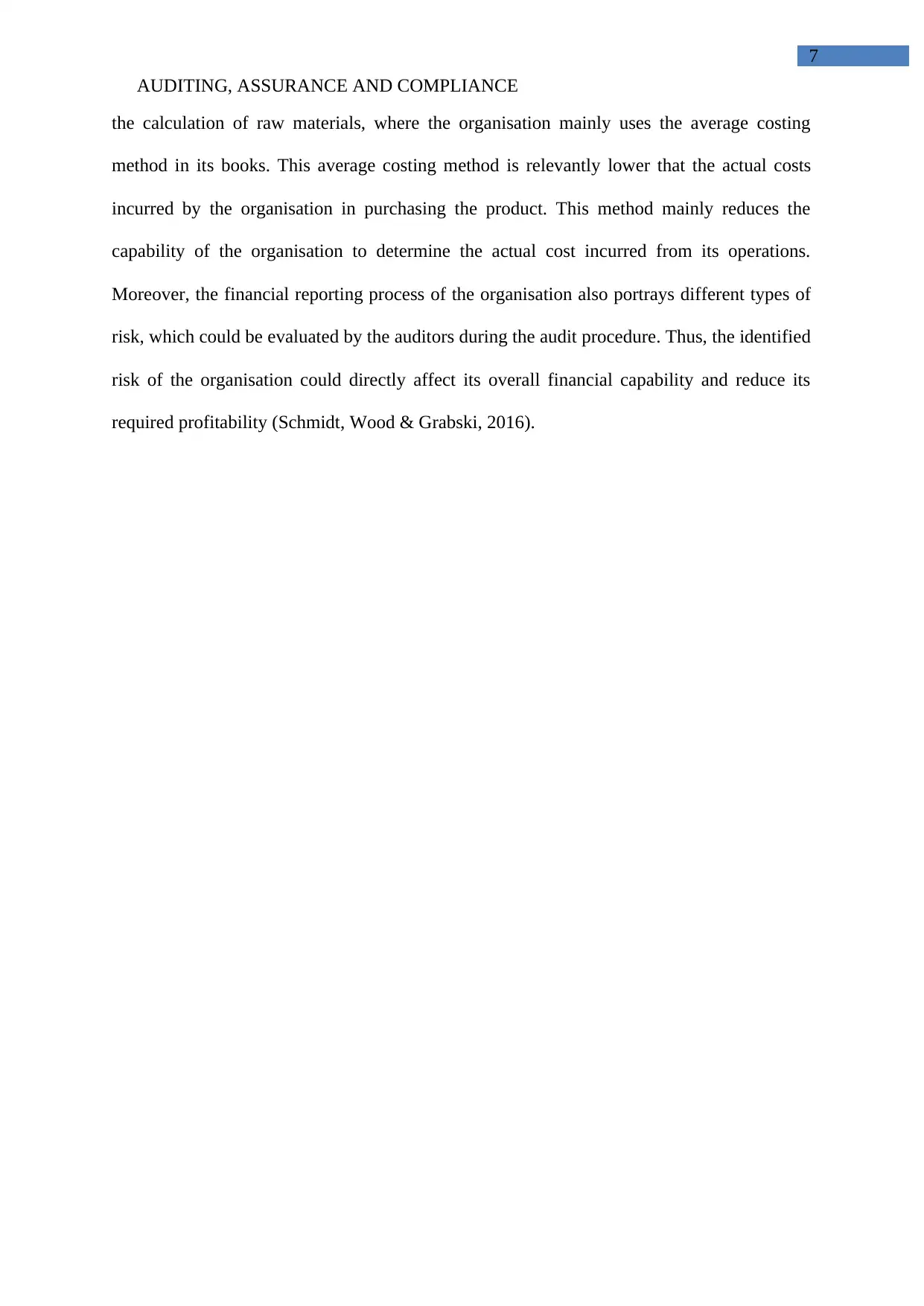
AUDITING, ASSURANCE AND COMPLIANCE
7
the calculation of raw materials, where the organisation mainly uses the average costing
method in its books. This average costing method is relevantly lower that the actual costs
incurred by the organisation in purchasing the product. This method mainly reduces the
capability of the organisation to determine the actual cost incurred from its operations.
Moreover, the financial reporting process of the organisation also portrays different types of
risk, which could be evaluated by the auditors during the audit procedure. Thus, the identified
risk of the organisation could directly affect its overall financial capability and reduce its
required profitability (Schmidt, Wood & Grabski, 2016).
7
the calculation of raw materials, where the organisation mainly uses the average costing
method in its books. This average costing method is relevantly lower that the actual costs
incurred by the organisation in purchasing the product. This method mainly reduces the
capability of the organisation to determine the actual cost incurred from its operations.
Moreover, the financial reporting process of the organisation also portrays different types of
risk, which could be evaluated by the auditors during the audit procedure. Thus, the identified
risk of the organisation could directly affect its overall financial capability and reduce its
required profitability (Schmidt, Wood & Grabski, 2016).
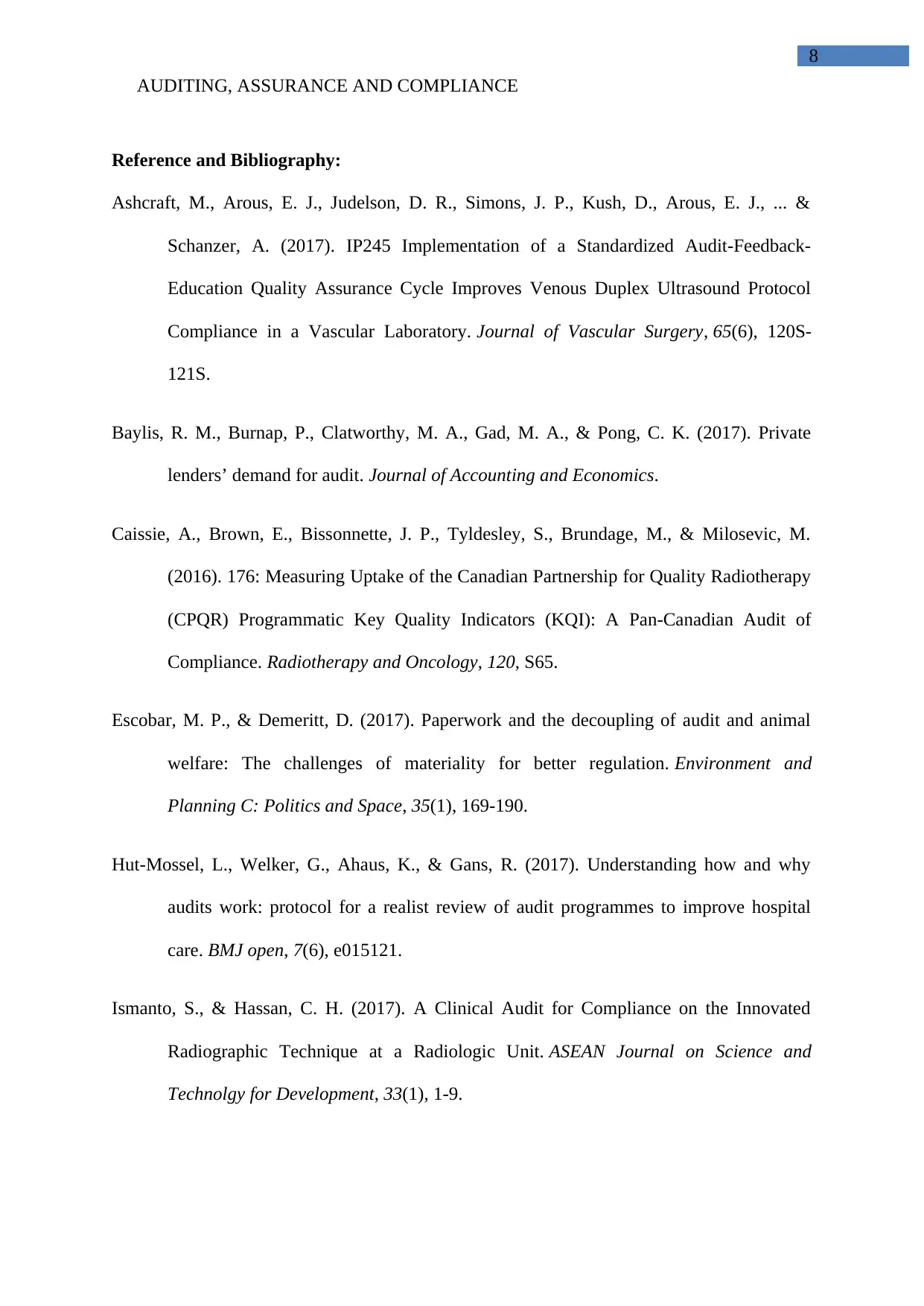
AUDITING, ASSURANCE AND COMPLIANCE
8
Reference and Bibliography:
Ashcraft, M., Arous, E. J., Judelson, D. R., Simons, J. P., Kush, D., Arous, E. J., ... &
Schanzer, A. (2017). IP245 Implementation of a Standardized Audit-Feedback-
Education Quality Assurance Cycle Improves Venous Duplex Ultrasound Protocol
Compliance in a Vascular Laboratory. Journal of Vascular Surgery, 65(6), 120S-
121S.
Baylis, R. M., Burnap, P., Clatworthy, M. A., Gad, M. A., & Pong, C. K. (2017). Private
lenders’ demand for audit. Journal of Accounting and Economics.
Caissie, A., Brown, E., Bissonnette, J. P., Tyldesley, S., Brundage, M., & Milosevic, M.
(2016). 176: Measuring Uptake of the Canadian Partnership for Quality Radiotherapy
(CPQR) Programmatic Key Quality Indicators (KQI): A Pan-Canadian Audit of
Compliance. Radiotherapy and Oncology, 120, S65.
Escobar, M. P., & Demeritt, D. (2017). Paperwork and the decoupling of audit and animal
welfare: The challenges of materiality for better regulation. Environment and
Planning C: Politics and Space, 35(1), 169-190.
Hut-Mossel, L., Welker, G., Ahaus, K., & Gans, R. (2017). Understanding how and why
audits work: protocol for a realist review of audit programmes to improve hospital
care. BMJ open, 7(6), e015121.
Ismanto, S., & Hassan, C. H. (2017). A Clinical Audit for Compliance on the Innovated
Radiographic Technique at a Radiologic Unit. ASEAN Journal on Science and
Technolgy for Development, 33(1), 1-9.
8
Reference and Bibliography:
Ashcraft, M., Arous, E. J., Judelson, D. R., Simons, J. P., Kush, D., Arous, E. J., ... &
Schanzer, A. (2017). IP245 Implementation of a Standardized Audit-Feedback-
Education Quality Assurance Cycle Improves Venous Duplex Ultrasound Protocol
Compliance in a Vascular Laboratory. Journal of Vascular Surgery, 65(6), 120S-
121S.
Baylis, R. M., Burnap, P., Clatworthy, M. A., Gad, M. A., & Pong, C. K. (2017). Private
lenders’ demand for audit. Journal of Accounting and Economics.
Caissie, A., Brown, E., Bissonnette, J. P., Tyldesley, S., Brundage, M., & Milosevic, M.
(2016). 176: Measuring Uptake of the Canadian Partnership for Quality Radiotherapy
(CPQR) Programmatic Key Quality Indicators (KQI): A Pan-Canadian Audit of
Compliance. Radiotherapy and Oncology, 120, S65.
Escobar, M. P., & Demeritt, D. (2017). Paperwork and the decoupling of audit and animal
welfare: The challenges of materiality for better regulation. Environment and
Planning C: Politics and Space, 35(1), 169-190.
Hut-Mossel, L., Welker, G., Ahaus, K., & Gans, R. (2017). Understanding how and why
audits work: protocol for a realist review of audit programmes to improve hospital
care. BMJ open, 7(6), e015121.
Ismanto, S., & Hassan, C. H. (2017). A Clinical Audit for Compliance on the Innovated
Radiographic Technique at a Radiologic Unit. ASEAN Journal on Science and
Technolgy for Development, 33(1), 1-9.
⊘ This is a preview!⊘
Do you want full access?
Subscribe today to unlock all pages.

Trusted by 1+ million students worldwide
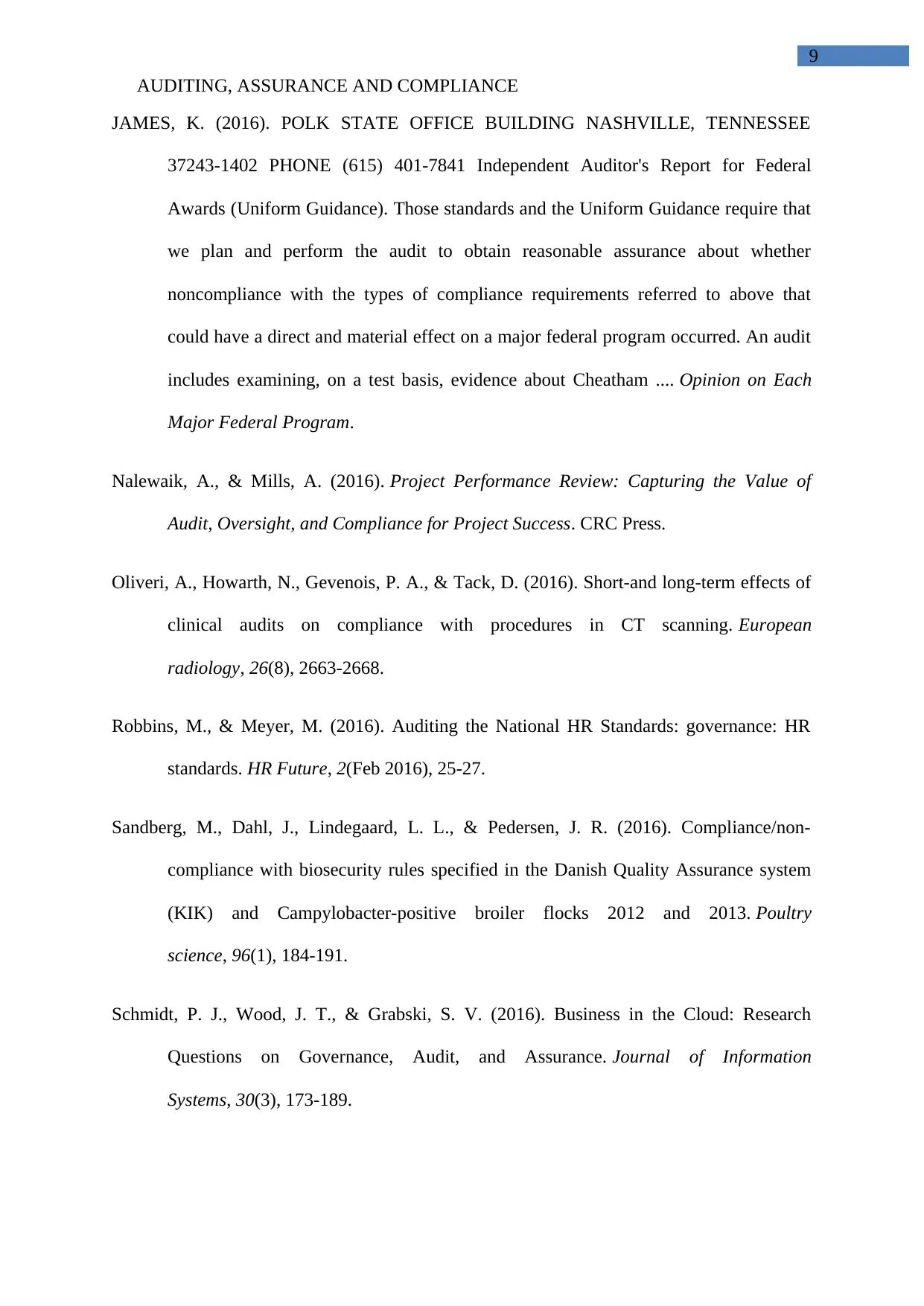
AUDITING, ASSURANCE AND COMPLIANCE
9
JAMES, K. (2016). POLK STATE OFFICE BUILDING NASHVILLE, TENNESSEE
37243-1402 PHONE (615) 401-7841 Independent Auditor's Report for Federal
Awards (Uniform Guidance). Those standards and the Uniform Guidance require that
we plan and perform the audit to obtain reasonable assurance about whether
noncompliance with the types of compliance requirements referred to above that
could have a direct and material effect on a major federal program occurred. An audit
includes examining, on a test basis, evidence about Cheatham .... Opinion on Each
Major Federal Program.
Nalewaik, A., & Mills, A. (2016). Project Performance Review: Capturing the Value of
Audit, Oversight, and Compliance for Project Success. CRC Press.
Oliveri, A., Howarth, N., Gevenois, P. A., & Tack, D. (2016). Short-and long-term effects of
clinical audits on compliance with procedures in CT scanning. European
radiology, 26(8), 2663-2668.
Robbins, M., & Meyer, M. (2016). Auditing the National HR Standards: governance: HR
standards. HR Future, 2(Feb 2016), 25-27.
Sandberg, M., Dahl, J., Lindegaard, L. L., & Pedersen, J. R. (2016). Compliance/non-
compliance with biosecurity rules specified in the Danish Quality Assurance system
(KIK) and Campylobacter-positive broiler flocks 2012 and 2013. Poultry
science, 96(1), 184-191.
Schmidt, P. J., Wood, J. T., & Grabski, S. V. (2016). Business in the Cloud: Research
Questions on Governance, Audit, and Assurance. Journal of Information
Systems, 30(3), 173-189.
9
JAMES, K. (2016). POLK STATE OFFICE BUILDING NASHVILLE, TENNESSEE
37243-1402 PHONE (615) 401-7841 Independent Auditor's Report for Federal
Awards (Uniform Guidance). Those standards and the Uniform Guidance require that
we plan and perform the audit to obtain reasonable assurance about whether
noncompliance with the types of compliance requirements referred to above that
could have a direct and material effect on a major federal program occurred. An audit
includes examining, on a test basis, evidence about Cheatham .... Opinion on Each
Major Federal Program.
Nalewaik, A., & Mills, A. (2016). Project Performance Review: Capturing the Value of
Audit, Oversight, and Compliance for Project Success. CRC Press.
Oliveri, A., Howarth, N., Gevenois, P. A., & Tack, D. (2016). Short-and long-term effects of
clinical audits on compliance with procedures in CT scanning. European
radiology, 26(8), 2663-2668.
Robbins, M., & Meyer, M. (2016). Auditing the National HR Standards: governance: HR
standards. HR Future, 2(Feb 2016), 25-27.
Sandberg, M., Dahl, J., Lindegaard, L. L., & Pedersen, J. R. (2016). Compliance/non-
compliance with biosecurity rules specified in the Danish Quality Assurance system
(KIK) and Campylobacter-positive broiler flocks 2012 and 2013. Poultry
science, 96(1), 184-191.
Schmidt, P. J., Wood, J. T., & Grabski, S. V. (2016). Business in the Cloud: Research
Questions on Governance, Audit, and Assurance. Journal of Information
Systems, 30(3), 173-189.
1 out of 10
Related Documents
Your All-in-One AI-Powered Toolkit for Academic Success.
+13062052269
info@desklib.com
Available 24*7 on WhatsApp / Email
![[object Object]](/_next/static/media/star-bottom.7253800d.svg)
Unlock your academic potential
Copyright © 2020–2025 A2Z Services. All Rights Reserved. Developed and managed by ZUCOL.





